Mammals
On Saint Martin, the only native mammals are bats, although dolphins and whales may be seen in the surrounding seas, either year-round or seasonally. The majority of mammals on the island are introduced species, including livestock, pets and pests.
In prehistoric times, there were at least two native rodents, the blunt-toothed giant hutia (Amblyrhiza inundata), which may have been as large as 200 kg, and a much smaller, semi-aquatic oryzomyine. While it is unclear if the giant hutia was present when the island was first colonized by the Arawaks (the first known human residents of the island), oryzomyine remains have been found at archaeological sites on the island.
Bats
There are thought to be eight species of bat (order Chiroptera) currently on the island: the greater fishing bat (Noctilio leporinus mastivus), the insular long-tongued bat (Monophyllus plethodon luciae), the Antillean cave bat (Brachyphylla cavernarum cavernarum), the Lesser Antillean tree bat (Ardops nichollsi montserratensis), the Jamaican fruit-eating bat (Artibeus jamaicensis jamaicensis), the Lesser Antillean funnel-eared bat (Natalus stramineus stramineus), the Brazilian free-tailed bat (Tadarida brasiliensis antillularum) and Pallas’ mastiff bat (Molossus molossus molossus). Bats may often be seen flying at night, and also roost in some buildings. There are also two caves on the island where several species are known to roost.
Due to the difficulty in identifying bats from photos (versus captured specimens), the identifications in this section are tentative. Some characteristics, such as color, size and presence of a noseleaf may be seen in photos. Others, like whether the tail extends beyond the tail membrane, may not be ascertained by photos alone.
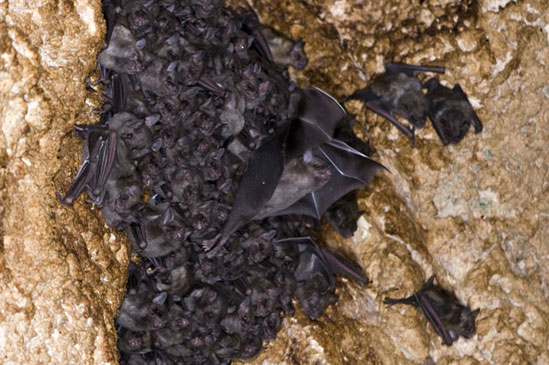
A large cluster of bats (probably Brachyphylla cavernarum cavernarum) roosting in La Grotte de Puits de Terres Basses in the lowland area of the island. Hundreds of bats from several species of bat have been observed in this large cave.
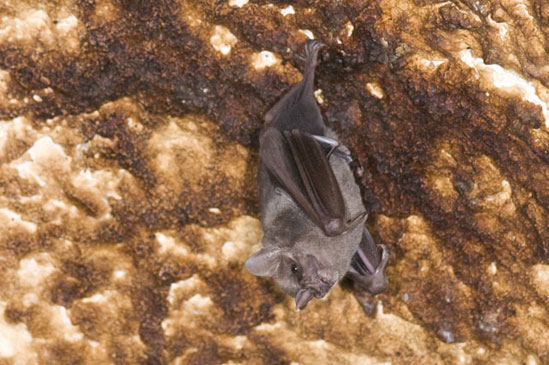
A single bat, likely Artibeus jamaicensis, hangs from the ceiling of La Grotte de Puits de Terres Basses. The floor of the western chamber of the cave was covered in almond seeds and fruit pits.
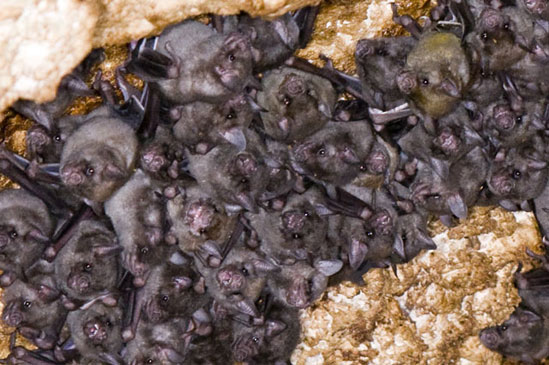
A large mass of what are probably Brachyphylla cavernarum cavernarum in the eastern chamber of La Grotte de Puits. Although this chamber hosts multiple species, the floor was not covered with fruit pits.
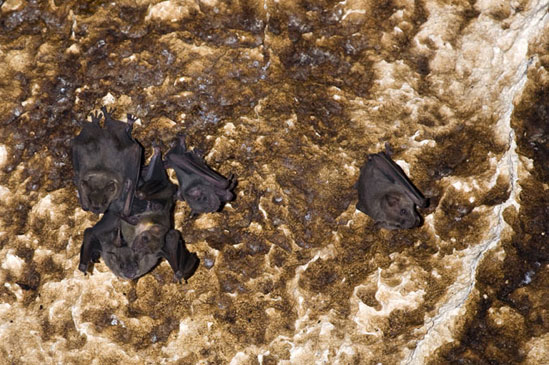
This small group seems to include a mother and at least two young, one of which is clinging to the mother. The species seems to be Artibeus jamaicensis.
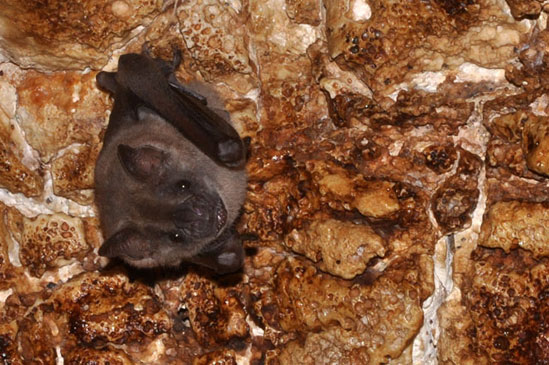
Another likely Artibeus jamaicensis, found in a cave at the top of Billy Folly on the Dutch side of the island. These are thought to be the most common bats on the island.
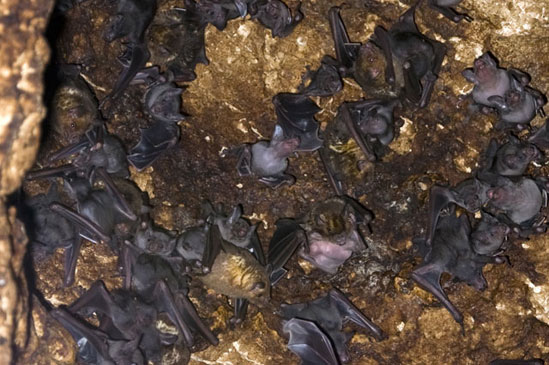
This appears to be a Brachyphylla cavernarum cavernarum maternity colony in a recess in the ceiling of La Grotte de Puits. Larger adults are mixed with what appear to be juvenile bats.
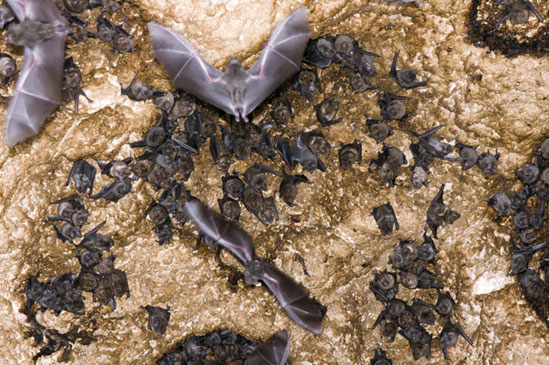
Bats in flight and roosting on the ceiling of La Grotte de Puits. In addition to smaller maternity colonies, large masses of bats, including dozens or hundreds pressed together, may be found.
Introduced Mammals
Several species of mammal have been introduced to Saint Martin over the years. Black rats (Rattus rattus) and mice (Mus musculus and perhaps other species) have probably been here since the first European settlement of the island. I have noticed rats mostly in populated areas, and some particularly agile individuals can be seen performing tightrope antics on power cables at night. I have seen mice under a board in a field in La Savane, but I would guess they are quite widespread. I have also encountered mouse bones in bird pellets.
The small Asian mongoose (Herpestes javanicus) was introduced to Saint Martin in 1888, and is still found on the island. Presumably introduced to control snakes (although at the time of introduction there was likely only one, non-venomous species of snake), the mongoose has likely contributed to the decline of local reptile populations since its introduction.
This small, elongated varmint is usually gray-brown and I have only seen it briefly before it retreats into the woods or the shelter of a pile of brush or bramble, in which I would guess they have a burrow. I have seen it on Pic Paradis, and in dry forest areas near Grand Case and Anse Marcel.
The raccoon (Procyon sp.) is a mysterious resident of the island. First documented on the island in 1957, it has been seen sporadically since. I found one raccoon carcass in the valley leading to Bell Beach, which would suggest that this animal is still living on the island. The method, date and reason for their introduction is unknown, but it is generally assumed that they were introduced by man, as is the case on several nearby islands.
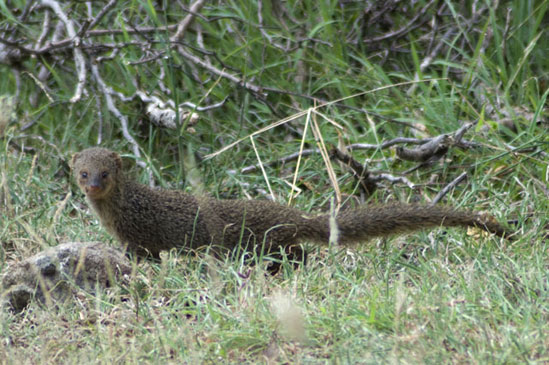
I have seen mongoose in both scrubland and densely forested areas on the island. They are wary of humans and tend to hide quickly. They are also curious and may return to investigate.
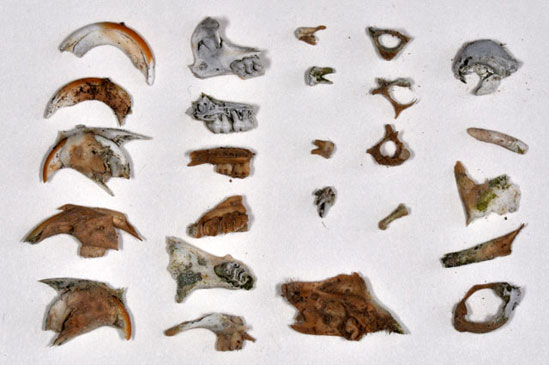
Rodent remains made up a large portion of some bird pellets I found.
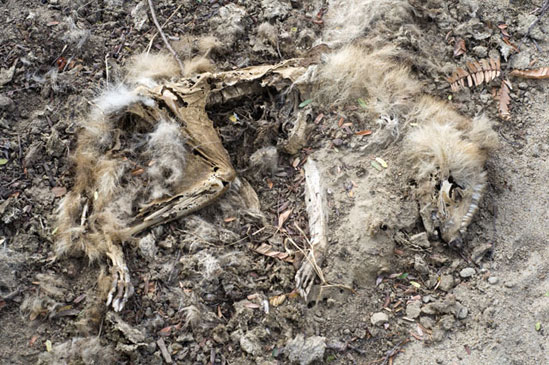
Raccoon carcass found in Bell Valley. How can you tell it’s a raccoon? In this case, I had also seen it a few weeks earlier when it was a little more recognizable.
Livestock and Pets
Livestock on the island includes goats (Capra aegagrus hircus), cattle (Bos primigenius), horses (Equus ferus caballus), donkeys (Equus africanus asinus) and pigs (Sus domestica), while cats (Felis catus) and dogs (Canis lupus familiaris) are kept as pets. A few goats, cats and dogs are feral, but most have human owners.
Goats are the most common mammalian livestock on Saint Martin and they can be seen roaming the hills, wandering down roadsides and tied in front yards. Although many goats may seem to be wild when out in the scrub, most are tagged on the ear and return to shelters for water daily. With voracious appetites, goats transform the landscape significantly. The fence lines demarcating goat pasture often also mark a stark division between closely-cropped grass and diverse scrubland.
By comparison, cattle seem to be much more selective in their eating habits and areas used for cattle pasture may retain a more natural appearance. Like most goats, cattle are typically left to roam large areas of hillside during the day, but return for water and shelter in the evening. In late afternoon, they may be heard calling loudly to other members of their herd.
Horses and donkeys are less common and typically corralled, rather than free ranging. I have seen pigs in and around a series of pens beside Étang Guichard near Friars’ Bay, and in Bell Valley, but they seem to make up a very small proportion of the livestock on the island.
Cats and dogs, while mostly pets, may also wander free as scavengers, particularly around towns, cities and developed beaches. I did once see a feral cat on the side of Bell Hill that I believe was living entirely in the wild. Having seen this only once in my many travels, I would guess this situation is relatively uncommon.
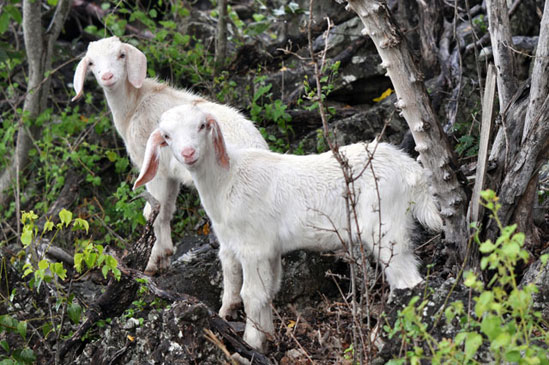
These goat kids were resting beneath a rocky overhang during an afternoon shower. While goats are often seen roaming freely over large areas of scrub and forest, the majority sport small plastic tags on their ears and return in the evenings for water and shelter.
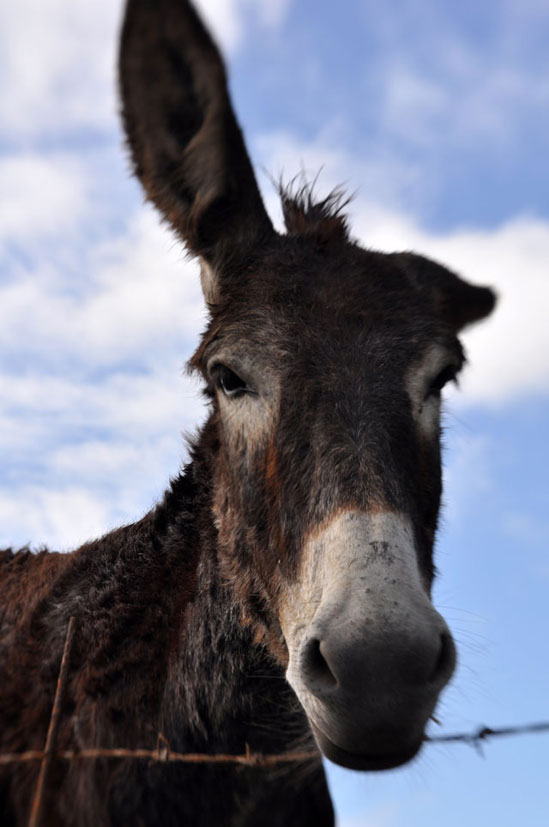
A donkey photographed near Cul de Sac. A large group of donkeys is sometimes present here and they are quite friendly or at least optimistic about receiving handouts.
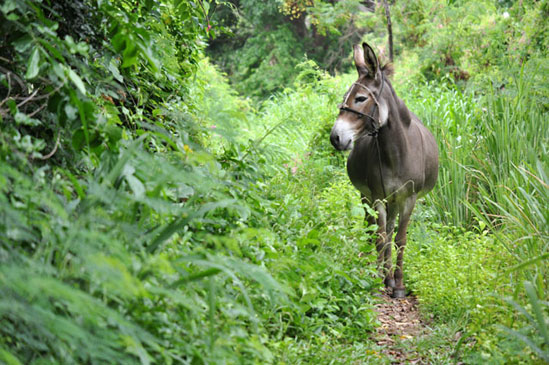
This small mule was tied up near a path in Colombier, and though somewhat frightened, was quite friendly.
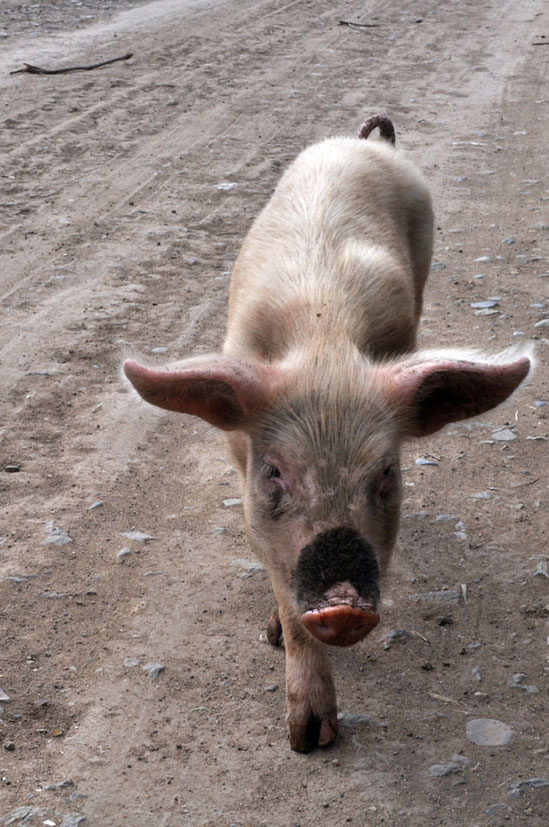
There are a number of pig enclosures along the shore of Étang Guichard near Friars’ Bay. While some pigs may be seen roaming freely in that area, there does not seem to be a wild population.
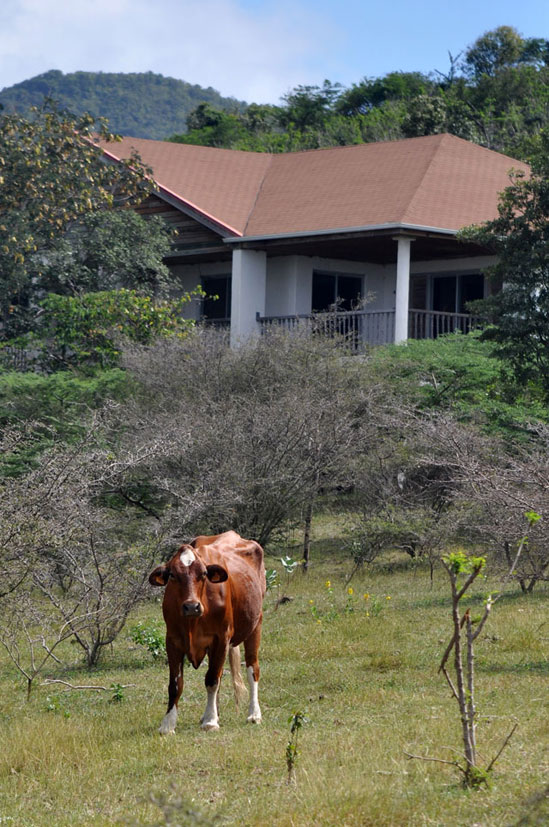
Cattle roam freely in many parts of the island, like this one in the abandoned, hurricane-damaged development near Happy Bay. Members of this herd are also frequently seen on the beach.
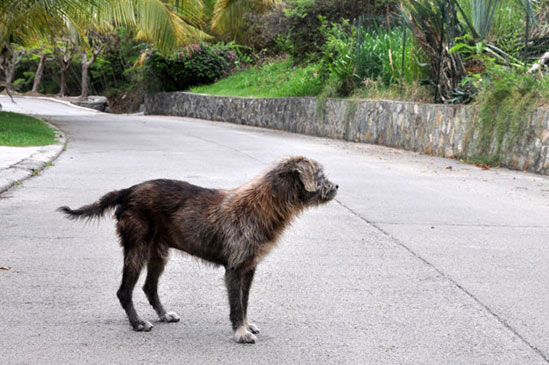
Dog and cat overpopulation is a serious problem on the island. The majority live in developed areas and scavenge refuse, which probably lessens their impact on more natural environments.
